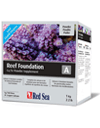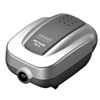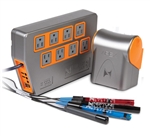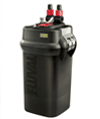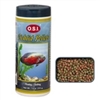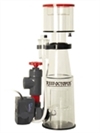Aquarium Media Reactor Overview
In recent years
media reactors have gotten more and more popular. Media reactors do one of two things.
- They maximize the effect of filtration media
- They allow you to use specialized filtration media
Adding a media reactor to your tank can help increase water clarity, reduce unwanted nutrients, and reduce algal growth in your aquarium.
Media Reactors
We sell several different
media reactors from Lifegard Aquatics, Two Little Fishies, Reef Octopus, ViaAqua, AquaTop, CPR and Kent Marine. They are all somewhat similar, but when choosing a reactor consider these factors:
- How large is your tank? Media reactors come in different sizes. The biggest we carry are the Reef Octopus MF-2000, Octo MF-800B and the Two Little Fishies Phosban Reactor 550. These are for your 200 gallon plus tanks. For smaller tanks we have the Lifegard Aquatics Turbo Reactor Nano, Two Little Fishies Reactor 150, and CPR Aquatics Tumbler Media Reactors.
- What sort of media are you using? Some reactors are made for coarse media, some for fine media and some for both types. The description for the reactor usually mentions the type of media that can be used with the reactor. Later in this article we also recommend some specific reactors for specific types of media.
- Where are you placing the reactor? Some reactors, like the popular Two Little Fishies Reactors, hang off the side of the tank. Other reactors, such as the Lifegard Reactors, need to be placed in the sump or submerged in the back compartment of a tank. In all cases the reactor will need a submersible pump that is in the tank or sump. The description of each reactor will specify where the reactor can be placed.
- What is included? Most reactors include a pump and all necessary fittings. The Two Little Fishies Reactors do not come with pumps or plumbing and hose to connect to the pump. The Reef Octopus MF-2000 also does not come with the pump. These reactors require a bit more planning, but they give you some flexibility with regards to setup.
Types Of Media
There are four types of media used in media reactors.
- Carbon
- Phosphate Removers
- Resins
- Biological Media
Each media accomplishes a different task.
Carbon
Carbon in a media reactor can help to focus water through the media so that the entire water volume of the tank is passed over the carbon several times per day. This is more effective than the common practice of placing a bag of carbon in your sump or back filtration compartment. When you do not use a reactor the water only moves in the general direction of the carbon and because the carbon offers resistance to water flow the water tends to circle around the carbon rather than passing through it.
Each reactor is a bit different and there are different types of carbon. If you wish to set up a reactor for a tank up to 150 gallons the Two Little Fishies PhosBan Reactor is a great choice. Here is a sample setup using the
Two Little Fishies Phosban Reactor 150 Package. This package includes the
Reactor 150,
Inland Sea Carbon, a
Lifegard Aquatics Quiet One Pro Model 400 Pump and
three feet of black tubing. Simply attach the Quiet One Pump to the Reactor using the included tubing.
When putting the Inland Seas Carbon into the Reactor you will want to use one of the sponges included with the Reactor at the bottom of the Reactor. Pour the carbon onto the top of the sponge. Put the second included sponge on top of the carbon to hold the carbon in place. The sponges will prevent the carbon dust from entering the aquarium. Carbon dust is believed to cause fish health problems including lateral line erosion. Sandwiching the carbon between the two sponges also prevents the carbon from tumbling and grinding itself into unhealthy dust.
Before putting the pump in the tank or the sump you will want to rinse the carbon. You can do this by running some clean water from one bucket, through the reactor and into another bucket. Rinse until the water runs clear.
Carbon is an excellent way to increase water clarity and reduce odors. It should be completely replaced every month.
Phosphate Removers
Phosphate removing media such as
PhosBan or
PhosGuard can also be used in a media reactor. Unlike with carbon, you do not want to sandwich the media between two sponges. Instead you want to tumble or fluidize the media. Phosphate removing media will not produce harmful dust as the material is much harder and it doesn’t crumble as easily. Tumbling the media also prevents water from channeling. Channeling is when the water finds the easiest route through the media and then continually passes through that route leaving very little water flow through other sections of the media. Tumbling the media constantly changes the position of the granules so that a channel never develops and all of the media is used.
You will need to adjust the flow rate into the reactor to achieve a proper tumble. Most reactors include a small ball valve to adjust the flow. If you need to purchase one separately the
Two Little Fishies (Low Pressure) Ball Valve works very well.
You want to set the flow rate so that you can see the surface of the media just barely turning over inside the reactor. If the flow is too great then the media can clog the reactor and flow back into your tank making a mess.
Phosphate media should still be rinsed before used in the same manner as carbon. The main benefits from phosphate reduction are algae control and more natural coral growth.
Resins
Resins are similar to carbon. But they typically remove more pollutants than carbon. When using resins like
Purigen and
Chemi-Pure in reactors make sure to follow the manufacturer’s recommendations as some resins will crumble into dust if tumbled while others benefit from tumbling. If you are unsure then simply sandwich the media between the sponges. The performance benefits of tumbling are not worth the risk of endangering the health of your fish. Resins should also be rinsed before used in a reactor, just like carbon and phosphate removers.
Biological Media
Biological media such as
Two Little Fishies NPX Bioplastics can also be used in reactors. These medias are used in reef aquariums to reduce nitrate and phosphate. This reduces algae, increases coral growth and color, and promotes fish health. They do this by providing bacteria that assimilates nitrate and phosphate (
which is then removed by the protein skimmer). The media in not replaced, but is periodically replenished as it is used up.
These medias need constant tumbling in a very aggressive manner for them to function. They require specialized media reactors that can deliver the proper flow rates for this fluidization. The
Lifeguard Turbo Reactors and
Reef Octopus Bio Churn Reactors are specifically designed to properly fluidize biopellets and include a properly sized pump for fluidizing the media. If you want a hang on reactor, you can use the
Two Little Fishies Phosban Reactor 150 (
but NOT the 550) for smaller tanks and the
Reef Octopus Octo Bio Churn 90HOB-EXT for larger tanks.







